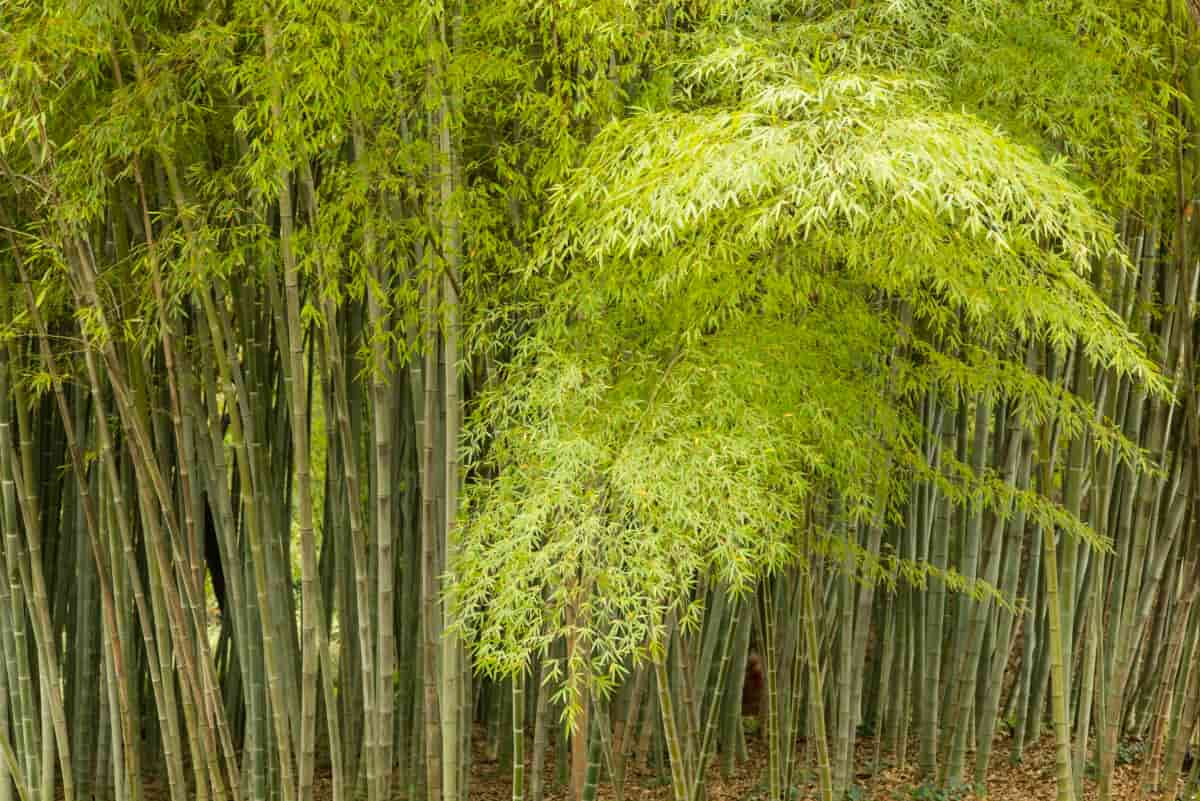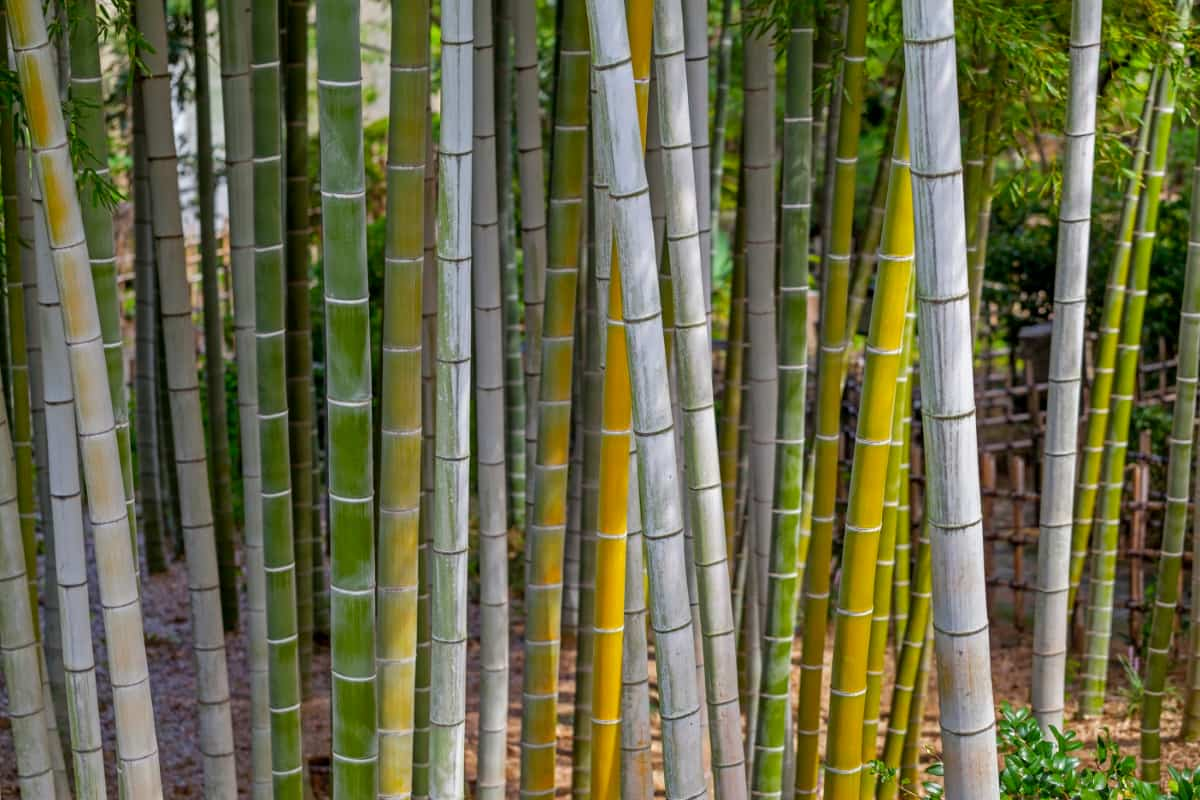Exploring the world of bamboo reveals a diverse and fascinating array of species. With over 10 different types of bamboo, these plants vary widely in size, appearance, and utility. In this article, we delve into some of the most notable types of bamboo, examining their unique characteristics and uses.

From giant varieties towering in the forests to smaller types ideal for gardens, bamboo’s versatility is unmatched. As we explore 10 different types of bamboo and their uses, we’ll also consider aspects like bamboo types by height and the best bamboo for garden spaces. Each type has its distinct features, making bamboo an incredibly diverse and useful plant family.
10 Different Types of Bamboo
Giant Bamboo (Dendrocalamus Asper)
Giant Bamboo, known for its impressive stature, stands out among bamboo types by height. This type of bamboo is a true giant in the plant world, often used in construction due to its robustness. Its thick, strong canes make it ideal for heavy-duty applications, from building materials to furniture.
In tropical regions, Giant Bamboo is a common sight, towering over other plants with its lush green foliage. Despite its size, it’s surprisingly fast-growing, making it a sustainable choice for large-scale uses. Its rapid growth and renewability also make it a popular choice among eco-conscious builders and designers.
Moso Bamboo (Phyllostachys Pubescens)
Moso Bamboo is one of the most popular types of bamboo in the world, known for its versatility and strength. It’s a key material in the manufacture of bamboo flooring and furniture. This variety of bamboo has the potential to reach significant heights, thereby becoming a prominent element in any landscape design. Moso Bamboo’s adaptability to different climates and soils makes it a favored choice for bamboo cultivation. Its dense growth habit and attractive appearance also make it a top pick for decorative purposes, both in gardens and as part of interior decor.
Bamboo (Bambusa Vulgaris)
Bambusa Vulgaris, often simply referred to as Bamboo, is a common variety seen around the world. Its adaptability to various climates makes it one of the most widespread types of bamboo. This species is known for its straight, tall canes and lush foliage, making it a popular choice for privacy screens and windbreaks in gardens. Its canes are also used in the production of furniture and crafts, showcasing the utility of bamboo in various forms. Bambusa Vulgaris represents the quintessential image of bamboo, embodying the grace and utility of this remarkable plant family.
In case you missed it: Drip Irrigation Cost for Bamboo Plantation: Exploring Installation Costs Along with Subsidy for 1-acre

Black Bamboo (Phyllostachys Nigra)
Black Bamboo, with its striking dark-colored canes, adds a unique aesthetic to any setting. This type of bamboo is especially popular in garden designs, where its contrasting color creates dramatic visual interest. Black Bamboo is not only about looks; its canes are also strong and flexible, making them useful for crafting and decorative purposes. This variety prefers a slightly shaded environment, making it suitable for gardens that don’t receive constant direct sunlight. Its distinctive appearance and practicality make Black Bamboo a sought-after variety among bamboo enthusiasts.
Timber Bamboo (Bambusa Textilis)
Timber Bamboo, as the name suggests, is widely used in construction and for making various bamboo products. This type of bamboo is renowned for its strong, straight canes, which are highly valued in the building industry. It’s one of the best bamboo for garden use as well, thanks to its elegant appearance and manageable growth habit. Timber Bamboo is often chosen for creating natural barriers and landscaping features, offering both beauty and functionality. Its durability and resistance to pests make it a practical and attractive option for many applications.
Guadua Bamboo (Guadua Angustifolia)
Guadua Bamboo stands out among bamboo types by height and strength, often used in large-scale construction projects. This type of bamboo is particularly valued in South America, where it’s used for building houses and bridges. Its thick walls and large diameter make it one of the strongest bamboo varieties, suitable for demanding structural applications. Guadua Bamboo is also an environmentally friendly choice, as it grows quickly and helps in carbon sequestration. Its role in sustainable architecture and green building practices highlights the ecological importance of bamboo.
In case you missed it: Best Fertilizers for Bamboo: Organic, Synthetic, Slow-release, NPK, and Liquid Fertilizers

Sasa Bamboo (Sasa Senanensis)
Sasa Bamboo is known for its compact size and dense foliage, making it one of the best bamboo for garden use, particularly in smaller spaces. This variety forms thick mats of foliage, ideal for ground cover and preventing soil erosion. Sasa Bamboo’s short stature and lush leaves also make it a great choice for creating a natural green backdrop in garden landscapes. Its capacity to flourish in diverse soil and climate conditions contributes to its appeal among gardeners seeking a low-effort yet aesthetically pleasing plant.
Yellow River Bamboo (Pseudosasa Amabilis)
Yellow River Bamboo, known for its striking yellow canes, adds a splash of color to any garden or landscape. This bamboo type is not only visually appealing but also versatile in its uses. It is commonly used for crafting and as a decorative element in landscaping. Yellow River Bamboo is an ideal choice for compact gardens or as a prominent feature in larger outdoor spaces due to its modest stature and non-spreading growth characteristics.
Arrow Bamboo (Plectocomiopsis Hainanensis)
Arrow Bamboo is a unique variety, notable for its slender, arrow-like canes. This type of bamboo is often used in crafting and as a material for making musical instruments due to its fine texture and strength. Arrow Bamboo is also appreciated for its ornamental value in gardens, where it creates a graceful, upright appearance. It flourishes in diverse climatic conditions and soil compositions, rendering it a versatile option for various landscaping requirements. Its distinctive form and utility make Arrow Bamboo a valuable addition to the diverse world of bamboo.
Golden Bamboo (Phyllostachys Aurea)
Golden Bamboo is a popular choice for its vibrant golden-colored canes and lush green foliage. This bamboo type is often used as a privacy screen or hedge in gardens due to its dense growth habit. It is also valued for its ornamental qualities, bringing a bright, cheerful element to garden designs. Golden Bamboo is adaptable to various soil types and environmental conditions, making it a practical choice for a wide range of landscapes. Its striking appearance and functional benefits make Golden Bamboo a sought-after variety among garden enthusiasts.
In case you missed it: How to Grow Lucky Bamboo in Soil: A Guide for Planting to Care

Conclusion
The world of bamboo is incredibly diverse and rich, offering a wide array of options for different needs and preferences. From the towering heights of Giant Bamboo to the dense foliage of Sasa Bamboo, each variety brings its unique qualities and uses. Bamboo plays a significant role in various industries, from construction to crafts, and is an essential element in garden and landscape design.
The 10 different types of bamboo discussed here highlight the plant’s versatility, ecological importance, and aesthetic value. Whether for practical use or decorative purpose, bamboo continues to be a valuable and sustainable resource, showcasing the harmony between nature and human ingenuity.
Note: The images presented in this post are intended solely for representation purposes. The images are meant to serve as visual aids and should not be relied upon as accurate representations of their real-life counterparts.
- Ultimate Guide to Ossabaw Island Hog: Breeding, Raising, Diet, and Care
- Ultimate Guide to Juliana Pig: Raising Facts, Size, Diet, Care, and Lifespan
- Raising Lleyn Sheep: Disadvantages, Price, Uses, Characteristics, and Care
- Ultimate Guide to Meishan Pig: Breed Facts, Breeding, Raising, and Care
- Ultimate Guide to Teacup Pigs: Raising, Diet, Lifespan, Cost, and Care
- Guide to Raising Poll Dorset Sheep: Facts, Profile, Characteristics, Uses, and Care
- Ultimate Guide to Bighorn Sheep: Characteristics, Diet, Lifespan, Breeding, and Lifecycle
- Ultimate Guide to Raising Katahdin Sheep: Farming Facts, Breed Profile, Uses, and Care
- Ultimate Guide to Raising Oreo Cows: Belted Galloways Farming Facts, Profile, Uses, and Care